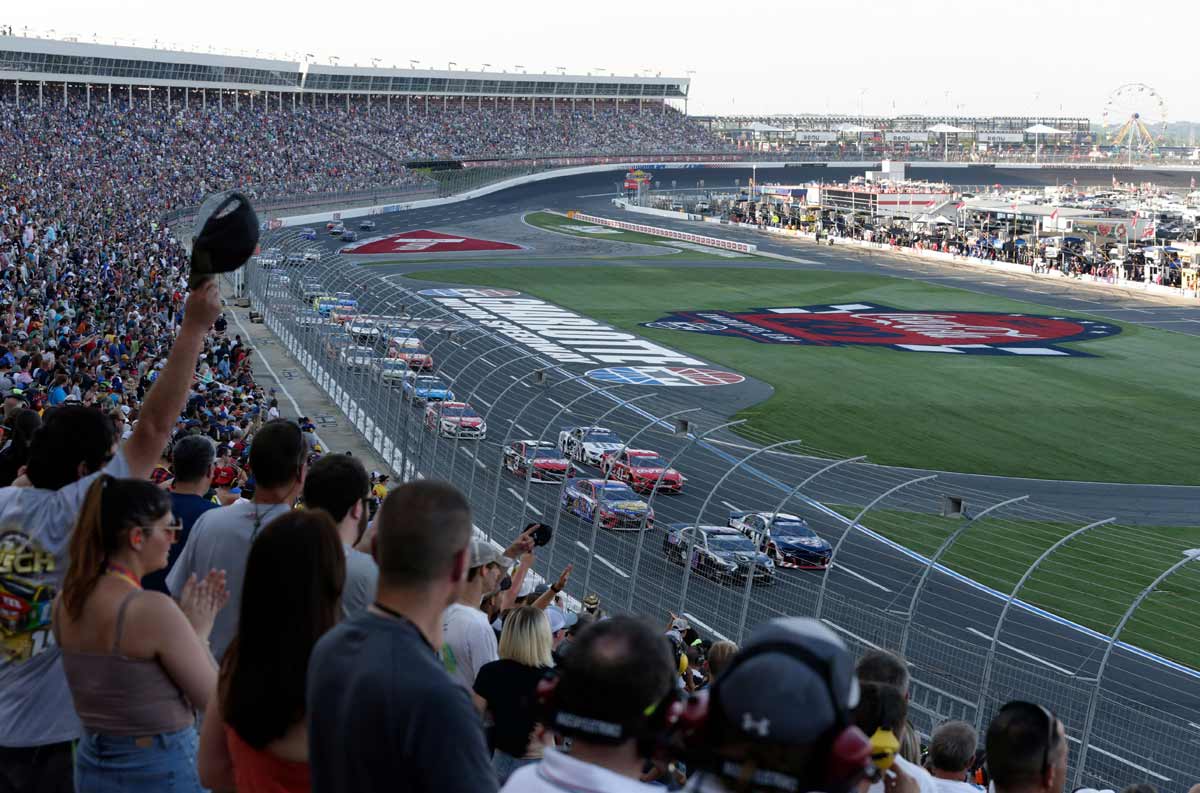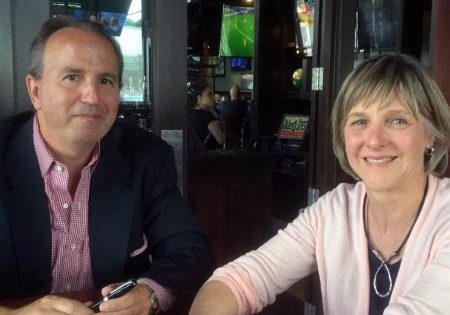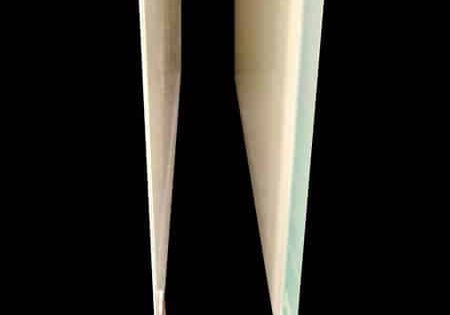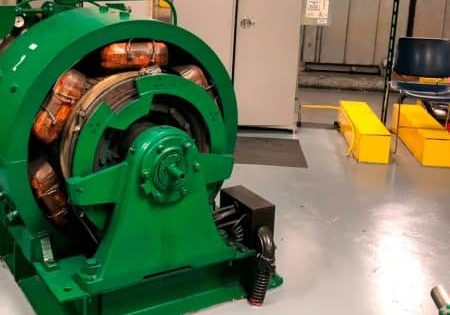Full Speed Ahead
Sep 1, 2019

Good learning, good networking, good times characterize EU’s 22nd annual conference in Charlotte, North Carolina.
Injuries, illness and a blackout failed to stifle the learning, fellowship and fun at the 22nd Annual Elevator U (EU) Educational Conference hosted by the University of North Carolina at Charlotte (UNC Charlotte) at Hilton Charlotte University Place on June 17-20. Highlights included presentations on elevator history, control systems, safety, door protection, hydraulic oils and university system management. The lively — at times, downright raucous — gathering was punctuated by a memorable visit to the Charlotte Motor Speedway.
Monday, June 17
In line with tradition, a golf outing was held at the Olde Sycamore Golf Plantation. It was followed by the EU Board of Directors (BoD) meeting in the Lakeshore ballroom at the Hilton. EU board member and ELEVATOR WORLD Vice President of Sales/Marketing Brad O’Guynn said they discussed making sure everything show-related was taken care of, especially since two board members were out: Terri Flint, who suffered a severe leg injury, and Tom Sybert, who was taking care of a sick loved one. The group reviewed presentations and noted how many of them were approved for continuing-education credit (National Association of Elevator Contractors [NAEC], 6.5 hr for Certified Elevator Technician (CET®)/Certified Accessibility and Private Residence Lift Technician (CAT®), and NAESA International, 2.5 hr for QEI certification), discussed finances and the number of registered attendees and exhibitors.
Also covered:
♦ United 2020 in Houston, which will bring together NAEC, the Canadian Elevator Contractors Association, the International Association of Elevator Consultants and EU under one roof, meaning organizations will not have standalone conferences
♦ Current EU membership being valid for two years
♦ Inviting all professional (university) EU members to attend United and join an EU board or committee
Tuesday, June 18
Registration commenced bright and early as attendees enjoyed breakfast featuring chicken and waffles. Everyone gathered in one of the spacious ballrooms for a day full of informative talks on history and vertical-transportation (VT) systems. Prior to that, however, EU President Eddie Morris took the mic to introduce Paul Taylor, zone maintenance facilities manager and Jon Varnell, associate vice chancellor for facilities, at UNC Charlotte, who described the history of the host university. It began in 1946 and, though it is “a pretty new school as far as elevators go,” it has grown considerably, now second only to North Carolina State University statewide in terms of number of elevators on campus.
EU member Dick Gregory then took the stage to say how much the team misses Flint, who is responsible for growing the organization and arranging events like EU (including all the delicious food). In response to Morris asking how many in the crowd are new to EU, a bunch of hands went up, prompting him to say, “Wow. I hope we continue to grow like this; it’s really amazing.” Morris shared that three charter buses would arrive that evening to transport attendees to the speedway and encouraged everyone to visit the vendor expo when it opened at lunch.
Presentations started out strong with Dr. Lee Gray, an EW correspondent and professor at the university, who took the audience on a fascinating trip through time, including great visuals, in “Elevator Research at American Universities 1890-2000.”
He began by talking about how early investigations sought to confirm manufacturers’ claims about the first electric elevator systems. He then touched on how research gradually changed over time to address the transition from operator-controlled to operator-less elevators, the fears that went with them and what elevator companies like Otis and Westinghouse did to alleviate those fears. In the 1950s, these companies implemented measures such as automated voice instructions and elevator music. Beginning the 1980s, Gray said, university research increasingly focused on the topic of traffic control and methods to determine how many elevators were required for a given setting.
Next up was Travis Hall of Alliance Elevator Solutions, who presented another trip through time — from the elevator Louis XIV used in the 1700s to transport his mistress to and from his rooms in Versailles, to the advent of machine-room-less (MRL) elevators in the 1990s — in “Elevator Selection for Low-Rise Buildings.” The ultimate message was that elevator selection is “all relative to your building.”
Rob Dirscherl’s topic and title belied an informed, entertaining rebel who minced no words and captivated the crowd with stories about the care and feeding of the 200-plus VT units at the University of Pennsylvania.
Hall’s talk included a thorough discussion of the pros and cons of MRL, hydraulic and hybrid systems.
After lunch, NAEC Executive Director Alesa McArthur and Morris talked about United, and how much they are looking forward to working together. “I am chair of the EU Education Board, and it’s amazing how much of the same types of education we want,” Morris observed. “I’m excited that EU will be part of United. We’re beginning to get some real traction.”
McArthur encouraged everyone to make plans to attend the NAEC convention in Grand Rapids, Michigan, this month, pointing out that, in addition to the networking opportunities of the show itself, the host city — which has earned the nickname “Beer City” because of all its microbreweries — is safe, clean and charming.
Next was a pair of surprisingly lively presentations: “The Advantage of a Complete Control System Package” by Tom Reamsnyder of Virginia Controls Inc. and “Working With AC Drives on Various Elevators and Systems” by Jeff Johnson of Magnetek. Reamsnyder described the history of controller packages, going over various types of driving machines and controllers from prehistoric times to present.
Calling input/output (I/O) algorithms in car operating panels and hall risers “a wonderful breakthrough,” Reamsnyder issued a reminder that in “ever more packaged” controller offerings, safety devices cannot be read strictly by software, but require programmable-logic-relay hardware.
He provided examples of packages for fixtures, doors and cabs, and the pros and cons of machine-room controllers. Such equipment is physically shrinking, he said, and elevator control is “less and less the job of a hoist.” That’s the good part; the bad part, he said, is some new packages are cramped and cryptic to troubleshoot. “Interestingly,” he noted, “some of these pros and cons mirror the raging MRL debate.”
New machine-room controller packages can involve an Ethernet hub that remotely monitors units throughout a campus, he said. A car-top I/O system is not an accessory, but rather a “vital organ” of the controller. “It’s similar to a machine-room controller but on a smaller scale,” he said.
Johnson’s presentation sparked lively discussion about average drive lifespan, a dearth of talent in the industry, the use of precious earth metals in components and compatibility issues created by proprietary equipment. Johnson urged everyone to visit elevatordrives.com and log on to Magnetek’s portal to access information about its AC drives and training materials. “The moral of the story today is easy online tools,” Johnson said.
After a long day of learning, it was time for some fun, with a trip to the Charlotte Motor Speedway. Approximately 125 guests boarded air-conditioned charter buses that took them about 20 min away to the track, an impressive facility that’s home to nationally prominent NASCAR races. Ensconced in a roomy, air-conditioned suite with its own padded bleachers, and bars serving craft beer and wine, guests mingled, chatted and dined on delicious catered barbecue as they watched hours of family-friendly entertainment.
Wednesday, June 19
Following nominations and voting, Vendor-Mercials, as usual, stole the show. “The bad news is I forgot to pack my ukulele,” said Joe Heastie of Castrol. “The good news is I’m going to give a dramatic reading and we only have five minutes.” Heastie gave a straightforward presentation with visuals about the evolution of the LubeCon automated lubrication system for VT equipment. Castrol now has LubeCon trials underway at three universities, and it is being implemented in the escalators of public-transit systems in cities including Detroit, Charlotte and Houston.
Product tests at six sites in Spain and Portugal are going very well, he said, and thyssenkrupp Europe has made LubeCon standard on all of its public-transit escalators. He asked any university representative interested in their university becoming the next test site to talk to him.
Circuit board provider Mathis Electronics’ Ed Mathis and Dima Kazantsev presented perhaps the funniest Vendor-Mercial, featuring Mathis as “PC Bae” (a nod to Salt Bae, the Turkish chef who spawned many an Internet meme thanks to his flamboyant style of salt sprinkling) who sported his own signature PC Bae shirt (a hot item at that evening’s Elevator Escalator Safety Foundation [EESF] silent auction fundraiser) and talked about the advantages of newer electronics. Not only are they “Made in America,” PC Bae said, but they never glow or flicker like the “wobbly incandescent balls” of yesteryear. When PC Bae forgot to say his “Made in America” catchphrase, he received a swift kick in the rear from his handler, Kazantsev, who invited everyone to stop by the Mathis booth to have any circuit-board questions answered.
Brittany Brothers of SnapCab then led the company’s popular over/under game, throwing out SnabCab socks to the people who shouted out correct answers first. Jonathan Latham of Janus showed a fun video about how the company’s products can prevent entrapments that can lead to uncomfortable — but funny, at least if it’s not you — scenarios like having to dine on packs of mints or urinate in the corner of the elevator.
Draka’s Kyle Hendren then passed out multifunctional PowerCube power strips to those with the right answers to elevator trivia questions.
O’Guynn gave his always well-received “State of the U.S. Elevator Industry” presentation before lunch and the opening of the expo. Within a few minutes, however, the power and lights went out at the hotel; apparently the blackout affected several city blocks. EU attendees went with the flow, cracking jokes about which elevator lighting displays were responsible and pulling out flashlight giveaways to illuminate the hamburger and hotdog buffet. The hotel was in darkness for approximately 40 min, and the facility’s staff handled it well.
After the impromptu candlelit lunch were “What’s New in ASME A18.1-2019, Part 8” and the “Nine Safety Absolutes,” both by John Rearick of codedataplate.com, then Rob Dirscherl of KONE, elevator contractor for the University of Pennsylvania, who presented “Long-Term Planning for Elevators & Escalators.”
Dirscherl’s topic and title belied an informed, entertaining rebel who minced no words and captivated the crowd with stories about the care and feeding of the 200-plus VT units at the University of Pennsylvania. As the “gatekeeper” for the system since the university fired its previous provider 18 years ago, Dirscherl said he has found that a focus on clear, frequent communication has resulted in elevator service calls on campus shrinking from 40 to 10 a day during his tenure.
That evening was the reopening of the vendor expo, but this time with an air of festivity with open bars flowing, a feast that included fried lobster balls and bidding/announcement of winners in the EESF silent auction.
Thursday, June 20
During the breakfast membership meeting, board member Glenn Duncan, who has “been with EU through thick and thin,” was thanked for his continued service. Attendees were invited to join the EU board or any of its committees, including a new one on specifications. Interested parties may contact any board member, whose contact information can be found at elevatoru.org.
EU Vice President Martin Culp reminded everyone that since EU is part of United, next year’s show will be four to five times bigger than typical, which this year, for example, had 46 vendors. He said, “This convention with vendors is what keeps us going financially, and we thank them.”
Culp then welcomed Matt Davies of Janus to the stage to present “Elevator Door Protection.” Davies talked about why elevator door protection is important (lawsuits, for one, and, “most importantly, it can be a matter of life or death”), Americans with Disabilities Act requirements that are being adopted state by state, the evolution of door-protection devices and an important update to ASME A17.1 coming later this year that requires 3D door detection be added. This, he says, “puts the U.S. on the forefront of
elevator safety.”
Sparking lively back and forth among audience members, “Facilities Management Best Practices — Elevator Design Criteria & Specification” offered a slide-rich presentation from Kevin Morse and Dale Hughes of Elevator Logic that delved into:
♦ Determining the right elevator system for your facility
(“Elevator companies will always try to sell you more units than you need.”)
♦ OSHA, National Aeronautics and Space Administration and U.S. military requirements
♦ Emergency Medical Services accessibility
♦ Machine-room accessibility
♦ Hoistway pit entrapment protection (from both flood and fire)
♦ Emergency egress
It had already been a long, intense day of education, but Doug Muennich of RelaDyne kept the crowd engaged with his excellent “Effects of Improperly Maintained Hydraulic Oils on Elevator Components” presentation — the last of the conference. In light of July being the 50th anniversary of the moon landing, he made the analogy that detrimental effects of oils on elevator components are like footprints on the moon.
These effects can be discovered using industrial forensic chemistry — specifically, thermal imaging — to “find the footprints left behind,” and discover “what happens to hydraulic oil when it fails and, more importantly, what happens to components.” It’s important to get a facility’s oils tested, he said, which prompted a question from your author that revealed there are several facilities that perform such testing for a surprisingly reasonable fee.
Morris described this year’s EU as memorable, with many attendees, including himself, experiencing their first auto race and a “pretty significant power outage.” Your author, for one, looks forward to attending another EU!
Get more of Elevator World. Sign up for our free e-newsletter.









